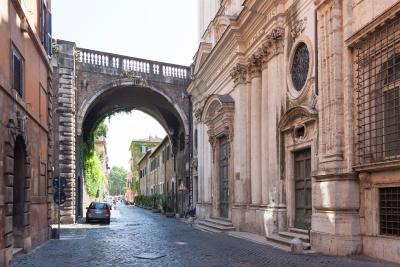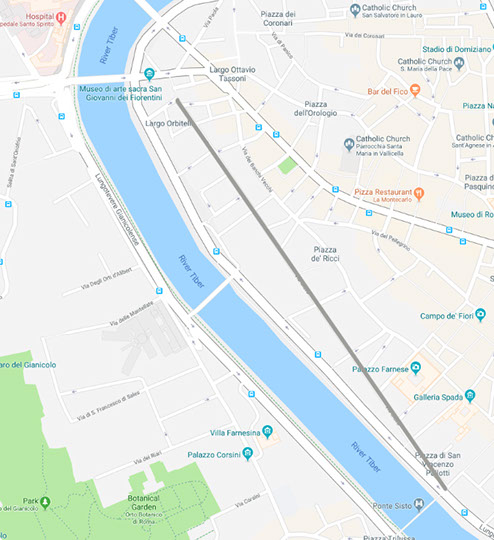Commissioned by Pope Julius II (for whom the street is named), Via Giulia was built in the early 16th century, part of a plan to build a square of roads near the Vatican. The project was never completed. But to this day, Via Giulia is lined with an array of extraordinary churches and cultural buildings, as well as some of the fanciest homes in Rome.
An Overview
Via Giulia offers an unusual walk for several reasons. It’s wide enough that you’re not dodging cars or inhaling fumes; arrow straight so you will not get lost; intimate and quiet enough to appreciate what you are seeing.
Via Giulia starts with an ivy-covered arch, designed by Michelangelo. It was part of another unrealized plan, this one to connect the Palazzo Farnese with the Villa Farnese, on the other side of the Tiber. The connection was never made, so the arch instead functions as a sort of majestic entryway.
Just after the arch is the white stone church of Santa Maria dell’Orazione e Morta, decorated with skulls and etchings of skeletons. This was home to the medieval fraternity who buried the dead found on the streets in Rome. Just beyond that is a gorgeous white palazzo belonging to the 16th.C. Falconieri family with a sumptuous inner courtyard. Remodeled in the 17th.C. by Borromini, it houses the Hungarian Academy.
After that, from the days when every nation and city-state had to have its own church in Rome, there are churches representing Spain, Armenia, Siena and Florence, to name just a few. Each church brings a taste of its home to Rome. The small Armenian church, for example, has a delicate iron cross on top and an iron fence that would seem more at home in the Armenian countryside.
The vast white Florentine church at the far end of the street, San Giovanni Battista dei Fiorentina, reflects the grandeur of the Medici family (who had a palazzo just next door). By far the largest and grandest church on Via Giulia, it was begun in the early 16th.C., took more than 200 years to complete and includes work by both Borromini and Bernini.
The Via Giulia is very much a street where people - most very rich - live. It has antiques shops as well as a high school, Liceo Virgilio.
And as a reminder of the darker side of life, Italy’s anti-Mafia commission has its imposing offices on Via Giulia housed in a vast former jail - thick bars on the windows speak of its prior function.




